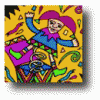Articles
Getting the most out of life - Part 2The idea is this. To start with, you will choose an envelope at random, say by tossing a coin, and look at its contents, which is a cheque for some number - say n. (By randomising like this, you can be sure I haven't subconsciously induced you to prefer one envelope or the other.) You want to make sure that the bigger the number is, the more likely you are to keep it, in other words, the less likely you are to swap.
Friends and strangersSometimes a mathematical object can be so big that, however disorderly we make the object, areas of order are bound to emerge. Imre Leader looks at the colourful world of Ramsey Theory.
Model TrainsAs customers will tell you, overcrowding is a problem on trains. Fortunately, mathematical modelling techniques can help to analyse the changing demands on services through the day. Tim Gent explains.
Measure for measureCan you imagine objects that you can't measure? Not ones that don't exist, but real things that have no length or area or volume? It might sound weird, but they're out there. Andrew Davies gives us an introduction to Measure Theory.
Maths on the tubeDuring World Mathematical Year 2000 a sequence of posters were displayed month by month in the trains of the London Underground aiming to stimulate, fascinate - even infuriate passengers! Keith Moffatt tells us about three of the posters from the series.
Cars in the next lane really do go fasterYes, you were right to wish you were in the other lane during this morning's commute! Nick Bostrom tells why we're usually caught in the slow lane.
Mathematical mysteries: What colour is my hat?This is a game played between a team of 3 people (Ann, Bob and Chris, say), and a TV game show host. The team enters the room, and the host places a hat on each of their heads. Each hat is either red or blue at random (the host tosses a coin for each team-member to decide which colour of hat to give them). The players can see each others' hats, but no-one can see their own hat.
Mathematical mysteries: Zeno's ParadoxesThe paradoxes of the philosopher Zeno, born approximately 490 BC in southern Italy, have puzzled mathematicians, scientists and philosophers for millennia. Although none of his work survives today, over 40 paradoxes are attributed to him which appeared in a book he wrote as a defense of the philosophies of his teacher Parmenides.
Rogue trading?The dangers of trading derivatives have been well-known ever since they were catapulted into the public eye by the spectacular losses of Nick Leeson and Barings Bank. John Dickson explains what derivatives are, and how they can be both risky, and used to reduce risk.
From quasicrystals to KleenexThis pattern with kite-shaped tiles can be extended to cover any area, but however big we make it, the pattern never repeats itself. Alison Boyle investigates aperiodic tilings, which have had unexpected applications in describing new crystal structures.
On the dissecting tableBill Casselman writes about the intriguing amateur mathematician Henry Perigal, who took his elegant proof of Pythagoras' Theorem literally to his grave - by having it carved on his tombstone.
Mathematical mysteries: The Solitaire AdvanceSolitaire is a game played with pegs in a rectangular grid. A peg may jump horizontally or vertically, but not diagonally, over a peg in an adjacent square into a vacant square immediately beyond. The peg which was jumped over is then removed.

